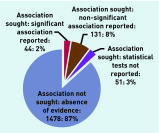Clinical presentation and microbiological diagnosis in paediatric respiratory tract infection: a systematic review
- PMID: 25624310
- PMCID: PMC4325442
- DOI: 10.3399/bjgp15X683497
Clinical presentation and microbiological diagnosis in paediatric respiratory tract infection: a systematic review
Abstract
Background: Antibiotic prescribing decisions for respiratory tract infection (RTI) in primary care could be improved if clinicians could target bacterial infections. However, there are currently no evidence-based diagnostic rules to identify microbial aetiology in children presenting with acute RTIs.
Aim: To analyse evidence of associations between clinical symptoms or signs and detection of microbes from the upper respiratory tract (URT) of children with acute cough.
Design and setting: Systematic review and meta-analysis.
Method: A literature search identified articles reporting relationships between individual symptoms and/or signs, and microbes detected from URT samples. Associations between pathogens and symptoms or signs were summarised, and meta-analysis conducted where possible.
Results: There were 9984 articles identified, of which 28 met inclusion criteria. Studies identified 30 symptoms and 41 signs for 23 microbes, yielding 1704 potential associations, of which only 226 (13%) have presently been investigated. Of these, relevant statistical analyses were presented for 175 associations, of which 25% were significant. Meta-analysis demonstrated significant relationships between respiratory syncytial virus (RSV) detection and chest retractions (pooled odds ratio [OR] 1.9, 95% confidence interval [CI] = 1.6 to 2.3), wheeze (pooled OR 1.7, 95% CI = 1.5 to 2.0), and crepitations/crackles (pooled OR 1.7, 95% CI = 1.3 to 2.2).
Conclusions: There was an absence of evidence for URT pathogens other than RSV. The meta-analysis identified clinical signs associated with RSV detection, suggesting clinical presentation may offer some, albeit poor, diagnostic value. Further research is urgently needed to establish the value of symptoms and signs in determining microbiological aetiology and improve targeting of antibiotics in primary care.
Keywords: child; diagnosis; microbiology; point-of-care systems; primary health care; respiratory tract infections.
© British Journal of General Practice 2015.
Figures





Similar articles
-
Immediate versus delayed versus no antibiotics for respiratory infections.Cochrane Database Syst Rev. 2023 Oct 4;10(10):CD004417. doi: 10.1002/14651858.CD004417.pub6. Cochrane Database Syst Rev. 2023. PMID: 37791590 Free PMC article.
-
Delayed antibiotic prescriptions for respiratory infections.Cochrane Database Syst Rev. 2017 Sep 7;9(9):CD004417. doi: 10.1002/14651858.CD004417.pub5. Cochrane Database Syst Rev. 2017. Update in: Cochrane Database Syst Rev. 2023 Oct 4;10:CD004417. doi: 10.1002/14651858.CD004417.pub6. PMID: 28881007 Free PMC article. Updated.
-
Signs and symptoms to determine if a patient presenting in primary care or hospital outpatient settings has COVID-19.Cochrane Database Syst Rev. 2022 May 20;5(5):CD013665. doi: 10.1002/14651858.CD013665.pub3. Cochrane Database Syst Rev. 2022. PMID: 35593186 Free PMC article.
-
[Volume and health outcomes: evidence from systematic reviews and from evaluation of Italian hospital data].Epidemiol Prev. 2013 Mar-Jun;37(2-3 Suppl 2):1-100. Epidemiol Prev. 2013. PMID: 23851286 Italian.
-
Delayed antibiotics for symptoms and complications of respiratory infections.Cochrane Database Syst Rev. 2004 Oct 18;(4):CD004417. doi: 10.1002/14651858.CD004417.pub2. Cochrane Database Syst Rev. 2004. Update in: Cochrane Database Syst Rev. 2007 Jul 18;(3):CD004417. doi: 10.1002/14651858.CD004417.pub3. PMID: 15495108 Updated.
Cited by
-
Assessing the potential of upper respiratory tract point-of-care testing: a systematic review of the prognostic significance of upper respiratory tract microbes.Clin Microbiol Infect. 2019 Nov;25(11):1339-1346. doi: 10.1016/j.cmi.2019.06.024. Epub 2019 Jun 26. Clin Microbiol Infect. 2019. PMID: 31254715 Free PMC article.
-
Evaluation of Alere i RSV for Rapid Detection of Respiratory Syncytial Virus in Children Hospitalized with Acute Respiratory Tract Infection.J Clin Microbiol. 2017 Apr;55(4):1032-1036. doi: 10.1128/JCM.02433-16. Epub 2017 Jan 11. J Clin Microbiol. 2017. PMID: 28077700 Free PMC article.
-
Impact of Rapid Molecular Detection of Respiratory Viruses on Clinical Outcomes and Patient Management.J Clin Microbiol. 2019 Mar 28;57(4):e01890-18. doi: 10.1128/JCM.01890-18. Print 2019 Apr. J Clin Microbiol. 2019. PMID: 30651392 Free PMC article.
-
Rapid and sensitive real-time assay for the detection of respiratory syncytial virus using RT-SIBA®.BMC Infect Dis. 2017 Feb 10;17(1):134. doi: 10.1186/s12879-017-2227-x. BMC Infect Dis. 2017. PMID: 28183291 Free PMC article.
-
Rapid respiratory microbiological point-of-care-testing and antibiotic prescribing in primary care: Protocol for the RAPID-TEST randomised controlled trial.PLoS One. 2024 May 20;19(5):e0302302. doi: 10.1371/journal.pone.0302302. eCollection 2024. PLoS One. 2024. PMID: 38768129 Free PMC article.
References
-
- National Institute for Health and Care Excellence . Respiratory tract infections: prescribing of antibiotics for self-limiting respiratory tract infections in adults and children in primary care Clinical guideline 69. London: NICE; 2008. http://publications.nice.org.uk/respiratory-tract-infections-antibiotic-... (accessed 26 Nov 2014). - PubMed
-
- Keith T, Saxena S, Murray J, Sharland M. Risk-benefit analysis of restricting antimicrobial prescribing in children: what do we really know? Curr Opin Infect Dis. 2010;23(3):242–248. - PubMed
-
- Adriaenssens N, Coenen S, Versporten A, et al. European Surveillance of Antimicrobial Consumption (ESAC): outpatient antibiotic use in Europe 1997–2009. J Antimicrob Chemother. 2011;66(Suppl 6):vi3–vi12. - PubMed
Publication types
MeSH terms
Grants and funding
LinkOut - more resources
Full Text Sources
Miscellaneous
